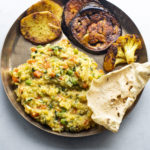Combine your rice and all the lentils in a bowl. Add water and mix around to wash thoroughly. Repeat this exercise 3-5 times until the water runs clear. Then add fresh water and let them soak for at least 2-3 hours.
In a heavy bottom pot, add the rice, lentils and 4 cups of water along with salt and turmeric powder. Bring it to a boil on a medium flame and then turn it to low to cook. Adjust with hot water to a desired consistency. You can use the back of your wooden spoon to gently mash the khichdi to get a creamy result.
In the final ten minutes of cooking, add the mixed vegetables and let them cook in the khichdi along with the rice and lentils.
When the vegetables are fully cooked, adjust with hot water to your desired consistency ( see notes) and turn off the heat. Add the chopped tomatoes, they soften just right in the residual heat.
In a separate pan, heat the ghee (use oil if vegan) for your tadka. Add your whole spices, asafoetida, garlic and spring onions and let them sizzle and frizzle. Cook until they have a bit of colour and no longer taste raw. Add into the khichdi and mix. Let it rest for 15 minutes before serving.
Best served with a side of crispy papad, pickle and or spiced oven roasted or pan fried vegetables (potatoes or eggplants particularly, but even cauliflower is great).
